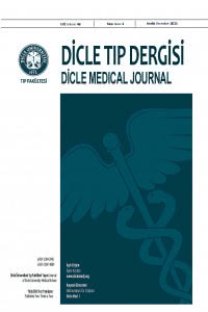Survival outcomes in patients with undifferentiated endometrial carcinoma
Andiferansiye endometrial karsinomlu hastalarda sağ kalım sonuçları
___
Acharya S, Hensley ML, Montag AC, Fleming GF. Rare uterine cancers. Vol. 6, Lancet Oncology. 2005. p. 961– 71.Ramalingam P, Masand RP, Euscher ED, Malpica A. Undifferentiated Carcinoma of the Endometrium: An Expanded Immunohistochemical Analysis Including PAX-8 and Basal-Like Carcinoma Surrogate Markers. Int J Gynecol Pathol. 2016; 35: 410-8.
Altrabulsi B, Malpica A, Deavers MT, et all. Undifferentiated carcinoma of the endometrium. Am J Surg Pathol. 2005; 29: 1316–21.
Silva EG, Deavers MT, Malpica A. Undifferentiated carcinoma of the endometrium: A review. Pathology. 2007; 39: 134–8.
Abeler VM, Nesland JM, Kjell E. Kjorstad. Undifferentiated carcinoma of the endometrium. A histopathologic and clinical study of 31 cases. Cancer. 1991; 68: 98–105.
Garg K, Soslow RA. Endometrial undifferentiated carcinomas. Pathology Case Reviews. 2011.
Espinosa I, Lee CH, D'Angelo E, Palacios J, Prat J. Undifferentiated and Dedifferentiated Endometrial Carcinomas With POLE Exonuclease Domain Mutations Have a Favorable Prognosis. Am J Surg Pathol. 2017 Aug; 41: 1121-8.
Eble, John N., Fattaneh A. Tavassoli, and Peter Devilee, eds. Pathology and Genetics of Tumours of the Breast and Female Genital Organs. Iarc, 2003.
Tafe LJ, Garg K, Chew I, Tornos C, Soslow RA. Endometrial and ovarian carcinomas with undifferentiated components: Clinically aggressive and frequently underrecognized neoplasms. Mod Pathol. 2010; 23: 781–9.
Koh WJ, Abu-Rustum NR, Bean S, et al. Uterine Neoplasms, Version 1.2018: Clinical practice guidelines in oncology. JNCCN Journal of the National Comprehensive Cancer Network. 2018.
Markman M. General principles: chemotherapy. In: Berek JS HN, editor. Practical Gynaecologic Oncology. Lipincott Williams and Wilkins; 2004. p. 91.
Hayashi M, Ueda Y, Takimoto T, Ohkura T. Undifferentiated endometrial carcinoma of the uterus: marked effect of chemotherapy with tetrahydropyranyl-adriamycin, paclitaxel, and carboplatin. Int J Gynecol Cancer. 2004; 14: 388-94
- ISSN: 1300-2945
- Yayın Aralığı: 4
- Başlangıç: 1963
- Yayıncı: Cahfer GÜLOĞLU
Katarakt Cerrahisi ile Aynı Seansta Skleral Askılı Göz İçi Lens Yerleştirilmesi
Selahattin BALSAK, Zeynep GÜRSEL ÖZKURT
Pulmonary hamartoma: Retrospective analysis of 24 cases
Miktat Arif HABERAL, Özlem ŞENGÖREN DİKİŞ, Erkan AKAR
İntraabdominal Apselerin Görüntüleme Eşliğinde Perkütan Drenajı
Çağrı DAMAR, Meltem ÖZDEMİR, Baki HEKİMOĞLU
Andiferansiye endometrial karsinomlu hastalarda sağ kalım sonuçları
Nezahat AKPOLAT, Narin GÜNDOĞUŞ, Kadri GÜL, Tuba DAL
Which Method is More Effective in Aerochamber Training in Pediatric Age Group?
MEHMET YAŞAR ÖZKARS, Serkan KİRİK
Narin GÜNDOĞUŞ, Kadri GÜL, Tuba DAL, NEZAHAT AKPOLAT
Arterial Thrombosis Secondary to Cardiac Catheterization in Neonates
SARA EROL, BANU AYDIN, Hasibe Gökçe ÇINAR, Tamer YOLDAŞ, AYŞEGÜL ZENCİROĞLU
İdrar Yolu Enfeksiyonu Geçiren Diyabetli Hastalarda Siprofloksasin İyi Bir Seçenek Değildir
Nevzat GOZEL, Ayse Sagmak TARTAR, Emir DONDER, Kader UĞUR, Bedrettin ORHAN, İsa Ahmet BAL, Abdullah Mubin ÖZERCAN
İbrahim KAPLAN, Mazhar Müslüm TUNA, Alpaslan Kemal TUZCU, Zafer PEKKOLAY, Zeki AKKUŞ, Şadiye ALTUN TUZCU, Mehmet GÜVEN
